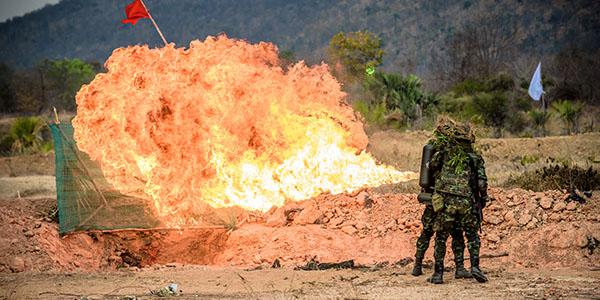Air Force Sets Ablaze Redundancy with Operation Flamethrower
The U.S. Air Force, led by Brig. Gen. Chad Raduege, USAF, the Air Combat Command’s A-6, along with Deputy Chief Information Officer Lauren Knausenberger, is pursuing Operation Flamethrower, an aggressive project to abandon legacy network-related policies, processes or equipment that are not working. The tongue-in-cheek name of the effort is meant to illuminate the nature in which leaders will eliminate ineffective or redundant components in order to drive innovation.
“We are ruthlessly going after these things and setting them on fire,” Knausenberger said.
For any processes that airmen perform manually, are time consuming and a burden, the service will venture to automate those tasks, she noted.
Operation Flamethrower is all about taking a legacy network into the future, Gen. Raduege explained. “We are going to rapidly identify legacy network things that have run aground,” he said. “It could either be policy limitations or redundant capabilities, any tools that are providing us with the things we don’t need, we are going to burn to the ground with a flamethrower.”
The Air Force is challenged with funding its digital transformation and has to find effective ways to advance its network capabilities under a tight budgetary structure, the general said. “Funding is always a challenge,” he observed. “And so, it is about how do we create offsets for the future network that we need. We are trying to find innovative ways to fund that network.”
The year-old Cyberspace Capabilities Center, also known as the Triple C and led by Col. Marc Packler, USAF, will also lend a hand in Operation Flamethrower. As part of its transformation, the Air Force combined its former Air Force Network Integration Center, Air Combat Command’s Cyberspace Support Squadron and the 38th Cyberspace Readiness Squadron, to create the Triple C, located at Scott Air Force Base.
“We are taking legacy processes and legacy equipment and figuring out how we can get it into the modern age,” Col. Packler stated. “We are eliminating pieces of equipment or processes or bureaucracy that do not need to be there.”
As part of the process, the leaders are encouraging airmen to voice their opinions on superfluous policies, processes and equipment. Knausenberger already is reaching out to airmen to get feedback on their information technology needs—especially during a shifting pandemic-induced telework environment—and is looking forward to crowdsourcing information from the airmen on any unnecessary policies or technologies.
The leaders added that the enterprise information technology as-a-service (EITaaS) component the service is pursuing is bringing in budget-friendly innovative technology. The Air Force is testing the EITaaS model at six of its bases, Knausenberger reported.
The A-6 confirmed that the EITaaS model is beginning to take root in the extended Air Force enterprise. “‘As-a-service’ has become common lingo with our acquisition professionals, with our operators and with our senior leaders, where they are understanding that industry can bring services as a service to our U.S Air Force and the Department of the Air Force,” the general stated.
In addition, the service is examining how it can improve and protect how it performs data sharing, especially in regard to potential risks from adversaries. “We have a lot of established infrastructure in a lot of known locations,” Gen. Raduege acknowledged. “Our adversaries are watching and they are gathering our dependency on data, gathering where we have our key nodes right now and we have to think through those challenges as we look to the future.”
The Air Force leaders spoke at the AFCEA Alamo Chapter’s annual ACE conference, held virtually last week.





Comments